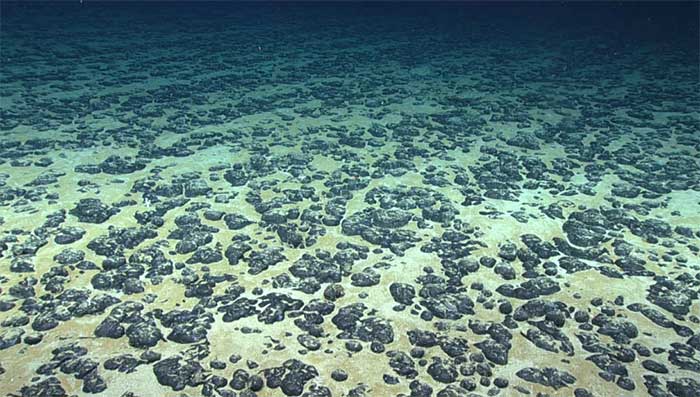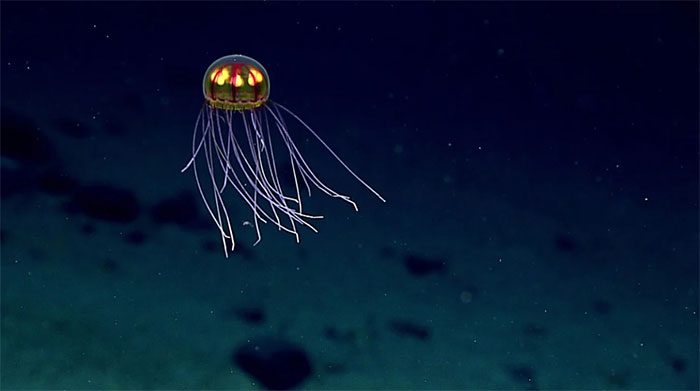The missing Titan submersible is one of the vehicles that help humanity explore the depths of the ocean, most of which have never been seen by the naked eye.
According to CNN, data from the National Oceanic and Atmospheric Administration (NOAA) in 2022 indicates that although humanity has explored the ocean floor for tens of thousands of years, only about 20% of the ocean floor has been mapped.

Manganese nodules on the ocean floor. (Image: CNN).
Researchers often say that space travel is easier than diving to the ocean’s depths. While 12 astronauts have spent a total of 300 hours on the surface of the Moon, only three people have spent around three hours exploring Challenger Deep, the deepest known point on Earth’s ocean floor.
Dr. Gene Feldman, an honorary oceanographer at NASA, stated: “In reality, we have clearer maps of the Moon and Mars than we do of our own planet.”
There is a reason why human exploration of the deep sea is so limited. Diving to the ocean floor means entering a world with extremely high pressure and significant risks. The dark environment offers almost no visibility. The temperatures are extremely cold.
The missing Titan submersible was exploring the wreck of the Titanic at a depth of about 3,800 meters underwater. The factors that make it difficult for rescue teams to locate and retrieve the vessel are also why comprehensive exploration of the ocean floor remains very challenging.
Dr. Jamie Pringle from Keele University in the UK remarked: “Underwater searches are quite complex, as the ocean floor is much more rugged than land.”
If the Titan submersible does not surface, search and rescue teams will need to rely on sonar, a technique that uses sound waves to probe the ocean’s murky depths to locate the vessel. According to Mr. Pringle, this process will require a very narrow beam capable of providing a sufficiently high frequency to create a clear picture of the vessel’s location.
History of Ocean Exploration

The Trieste submersible surfaces after making a world record dive at a depth of 3,150 meters on October 3, 1953. (Image: Getty Images).
The first submersible was designed by Dutch engineer Cornelis Drebbel in 1620, but it became stuck in shallow waters. It took nearly 300 years—after the Titanic disaster—before sonar technology was developed to help scientists gain a clearer picture of what lies beneath the ocean.
A significant advancement in human exploration occurred in 1960 with the historic dive of the Trieste to Challenger Deep, located at a depth of 10,916 meters underwater.
Only a few missions since then have taken humans back to such depths, and these trips are extremely dangerous.
According to NOAA, for every 10 meters traveled beneath the ocean surface, the pressure increases by one atmosphere. This means that a trip to Challenger Deep subjects a vessel to pressure equivalent to that of 50 gigantic jet airliners. Mr. Feldman added that at such pressures, even the smallest structural flaw could lead to disaster.
During the 1960 Trieste dive, passengers Jacques Piccard and Don Walsh expressed their astonishment at the life forms they encountered.
What Lies Beneath the Ocean Floor

A bioluminescent jellyfish captured during the exploration of the Mariana Trench in the Pacific Ocean in 2016. (Image: AP).
According to the Woods Hole Oceanographic Institution (WHOI) in Massachusetts, while the ocean floor ranges from 1,000 meters to 6,000 meters deep, deep-sea trenches can be as deep as 11,000 meters. This area is referred to as the hadal zone. In the hadal zone, temperatures are just above freezing, and no sunlight penetrates.
Scientists first demonstrated that life existed below 6,000 meters beneath the ocean floor in 1948.
Discoveries at Challenger Deep have been remarkable, as humans have observed vividly colored rock formations that may consist of chemical sediments, as well as supergiant amphibious creatures resembling shrimp and Holothurian species known as sea cucumbers residing on the ocean floor.
Mr. Feldman also reminisced about his dive in the 1990s when he saw a giant squid lurking in the pitch-black depths of the ocean. The first video footage of a living creature, possibly up to nearly 18 meters long, was captured in deep waters near Japan in 2012.
A new world also emerged in the 1970s when a completely alien ecosystem was discovered by marine geologist Robert Ballard, later at WHOI, in the waters near the Galápagos Rift. Giant worms, giant clams, giant crabs, and other living creatures were observed.
Researchers at WHOI and NASA have collaborated to develop autonomous underwater vehicles that can navigate through the complex terrain of trenches and withstand pressures over 1,000 times greater than those at the ocean’s surface. These vehicles can investigate the biodiversity of life in deep-sea trenches.
Why is Mapping the Ocean So Challenging?
From a scientific perspective, expeditions to the ocean floor do little to enhance our understanding of the ocean’s mysteries.
Mr. Feldman stated: “Humans are drawn to extremes. We want to visit the highest, lowest, and farthest places.”
However, humans only see a very small percentage of the vast ocean, and only a very small area of the ocean floor has been mapped.
According to Mr. Feldman, the primary reason is cost. Vessels equipped with sonar technology can incur exorbitant expenses. Fuel alone can reach up to $40,000 per day.
Scientists believe that mapping the ocean helps us understand how the shape of the ocean floor affects ocean currents and where marine life appears. It also aids in understanding seismic risks. Thus, this is a fundamental science that holds great importance for humanity.




















































